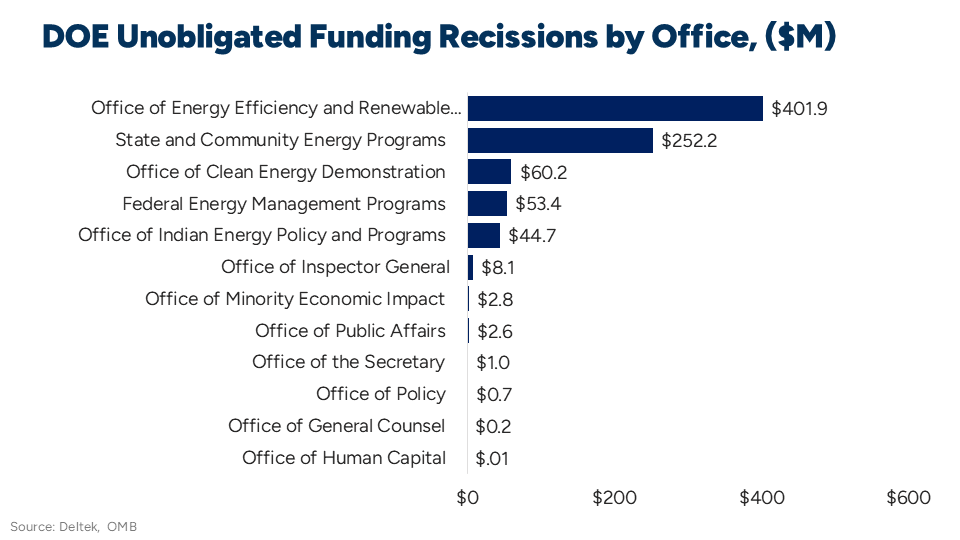Energy’s Proposed FY 2026 Budget Reductions Target Unobligated Funds
Published: May 29, 2025
The Department of Energy’s proposed $51.1B FY 2026 discretionary budget outlines a significant shift in the agency’s priorities. Secretary Wright says Energy can do more with less.
Recommended changes in the FY 2025 skinny budget and One Big Beautiful Bill eliminate the Infrastructure Investment and Jobs Act (IIJA) while prioritizing nuclear energy technologies, domestic fossil energy and critical minerals, energy storage and dominance in artificial intelligence.
“This budget will return DOE to its core mission of advancing energy innovation and global competitiveness through research and development,” Secretary of Energy Chris Wright told Congress last week. “We can do more with less.”
The skinny budget’s proposed more than $20B in cutbacks primarily target unobligated and uncommitted funding under the IIJA.
Proposed Reductions:
- IIJA: (-$15.3B) – Cancels funding for electric vehicle and battery manufacturing projects, climate-related and renewable energy demonstrations programs such as the Carbon Dioxide Transportation Infrastructure Finance and Innovation Act and unplanned and unallocated balances, excluding already awarded projects.
- Energy Efficiency and Renewable Energy (EERE): (-$2.6B, 74%) – Refocuses programs to early-stage research and development (R&D) programming; cancels IIJA climate-change activities (i.e., Justice40) and prioritizes firm baseload power technologies.
- Office of Science (Science): (-$1.2B, 14%) – Prioritizes U.S. competitiveness in high-performance computing, AI, quantum computing, information science, fusion and critical minerals and reduces funding for IIJA-related projects.
- Office of Nuclear Energy (NE): (-$408M, 24%) – Shifts focus to national energy security, AI-driven nuclear innovation and advanced reactor development and cuts funding for non-essential, lower-priority research projects.
- Office of Fossil Energy and Carbon Management (FE): (-$270, 31%) – Reverts office to original mission and office name; drives expansion of domestic fossil energy and critical mineral exploration, extraction and development; and cancels climate-related programs and regulations misaligned with current administration policies.
- Advanced Research Project Agency – Energy: (-$260, 57%) – Eliminates funding for IIJA-related projects refocusing on “fiscally responsible” energy and emerging technologies.

Additional Recissions:
The One Big Beautiful Bill also proposes rescinding unobligated Inflation Reduction Act (IRA) and funding under finance programs within several DOE offices including:
- State-Based Home Energy Efficiency Contractor Training Grants
- DOE Loan Programs Offices
- Advanced Technology Manufacturing
- Energy Infrastructure Reinvestment Financing
- Tribal Energy Loan Guarantee Program
- Transmission Facility financing
- Grants to Facilitate the Siting of Interstate Electricity Transmission Lines
- Interregional and Offshore wind Electricity Transmission Planning, Modeling, and Analysis
- Advanced Industrial Facilities Deployment Program
Staffing and Strategic Priorities:
In April, the agency identified more than 8,500 positions for potential elimination through attrition and reductions in force. During the May 21 Senate Hearing on FY 2026 Budget Hearing, when asked how the agency could complete its missions considering the recent resignations and firings. Wright assured the committee that critical programs such as for fusion, quantum computing, advanced AI would not be cut nor inhibited. Instead, the agency will refocus on fundamental basic and advanced sciences.
““The Department of Energy will advance these critical missions while cutting red tape increasing efficiency and unleashing innovation and ensuring we are better increasing efficiency and unleashing innovation and ensuring we are better stewards of taxpayer dollars.”
The problem is the labs have drifted into things that are not fundamental basic science, that are political science, and that's just not the missions of the labs,” he emphasized. “We're going to be smarter and more efficient but none of the top priorities you mentioned are going to be touched at all. My priorities for the department are clear: to unleash a golden era of American energy dominance, strengthen our national security and lead the world in innovation a reliable and abundant energy supply.”
Energy Strategic Goals:
- Establishing U.S. leadership in AI and scientific innovation for national and energy security
- Leveraging national laboratory expertise, research and development capabilities to meet growing energy demand, provide increased energy storage and ensure grid reliability
- Upgrade, modernize and the nation’s nuclear stockpile and power systems for naval vessels
- Removing regulatory and permitting barriers to domestic energy exploration and productions.
Despite budget and staffing reductions, federal contractors (and subcontractors) are necessary to support infrastructure upgrades, IT modernization and construction to achieve these goals. Contractor-provided IT support will enable DOE to harness artificial intelligence to design and develop small modular reactors. Transforming and replacing aging fossil fuel plants and building the planned 10 new large nuclear reactors by 2030 will drive increased opportunities in the architecture, engineering and construction sectors.
These will be driven by President Trump’s executive orders including the four issued May 23 to overhaul the U.S. nuclear energy program. Watch for next week’s blog as Deltek explores the details of those orders.